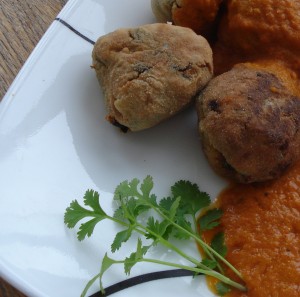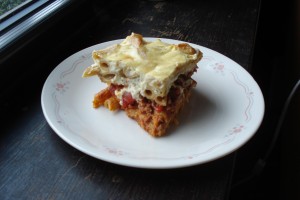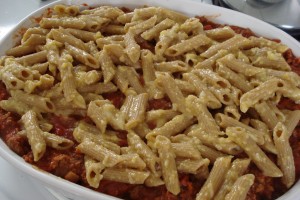Sometimes the simplest of foods can be the biggest headache in the kitchen. Such has been my experience with the from-scratch making of both noodles and breads; the lure of personal cookery collides with the demands of convenience in my kitchen, and often the result is that I rely on store-bought versions of these simple foods.
And yet, from time to time, the temptation to make these items from scratch reemerges. About a year ago, I got the idea in my head that I could save money by making my own bread for fondue. It’s bread, right? What could be so hard? Several hopelessly dense loaves later, I gave up on ever mastering the fluffy loaf. The more research I did, the more I realized how time- and planning-intensive it was to make a truly edible loaf of bread, and after so many failed attempts I didn’t want to invest in the often specialized ingredients for mastering this art. It wasn’t going to be cheaper if I had to invest in special bread flour or semolina. Convenience won out, and it was back to the Shop N’ Save bakery for their Italian loaf.
 My past forays into making noodles and pasta have yielded much more successful results. My dear friend, scholar and renaissance woman, Lisa Di, first introduced me to the wonders of fresh pasta (and bought me a pasta maker for my birthday). After garnering much of her wisdom for pasta fabrication, I produced many delicious and successful batches of fresh pasta; unfortunately, every inch of my kitchen was left covered in a thin film of flour. The ordeal of making the noodles and cleaning up after led me to the conclusion that most of the time, Barilla will serve.
My past forays into making noodles and pasta have yielded much more successful results. My dear friend, scholar and renaissance woman, Lisa Di, first introduced me to the wonders of fresh pasta (and bought me a pasta maker for my birthday). After garnering much of her wisdom for pasta fabrication, I produced many delicious and successful batches of fresh pasta; unfortunately, every inch of my kitchen was left covered in a thin film of flour. The ordeal of making the noodles and cleaning up after led me to the conclusion that most of the time, Barilla will serve.
While fresh, or at least refrigerated, pasta is readily available at most larger grocery stores, the item I do have trouble coming by is a good Asian noodle. Most regular grocery stores just don’t have a good selection of Asian noodles, and I don’t relish making a special trip down to the Strip District every time I want to make a noodle dish. For convenience, many of the Asian noodle recipes I find online simply call for pasta, instead of any particular type of noodle, but I’ve tried this and it just tastes wrong. Most store-bought Italian pastas are flour/water based noodles, giving them a lighter flavor and consistency. I’ve made fresh pasta in this way a number of times, simply adding water to flour, and it produced a noodle worthy of your best pesto or carbonara! But try putting it in your lo mein or peanut sauce, and it just tastes all wrong to me. Where can a gal get a nice squiggly egg noodle for her Asian cookery?
Of course, there are all manner of Asian noodles, and matching them up to any particular dish is an art unto itself. But, the other day, I just so happened to be looking up recipes, trying to decide what to make for my so-resolved weekly recipe experiments, when my co-worker ordered some lo mein from the local take place. Why couldn’t I make a noodle like that on my own? I knew I could, but did I want to go to all the trouble?
I resolved, at least, to search for recipes, and I found one that looked do-able, in large part because of its small scope. One major thing I find troubling about making noodles and bread is that most recipes I find for either one are enormous! I understand, in theory, that if you’re going to go to the trouble, might as well make a huge amount at one time and stock up. In reality, tackling the big to-do of an enormous noodle recipe makes me all the less likely to do it. If I have a smaller recipe that I can just mix up, roll out, and cut up-voila noodles!-I’m going to be much more likely to make it on a lazy Saturday afternoon.
Here’s what I found:
DOUGH FOR EGG NOODLES
2 cups flour
2 large eggs
1/2 teaspoon salt
3 tablespoons water
Combine flour and eggs in a large food processor until combined in a mealy consistency. Add salt as it processes, then add the water. Dough should form into a ball that cleans the sides of the food processor bowl.
So… my noodle dough didn’t exactly do this. Noodle and pasta dough is stiff, and while it looked like it was starting to form a ball, it also sounded like it was a threat to break my food processor, so I decided to take one for the team and do a little hand-kneading (even though the recipe touted itself as no-knead). Kneading on a board required more flour, of course, and as I set to rolling out the dough, I realized that I was actually doing myself no favors neglecting my pasta maker. Once I went to the trouble of unearthing my pasta maker from storage, it was actually rather fun to use, and since I made a small amount of dough, the rolling went quickly.
The core device of any pasta maker is the flat roller, two steel rollers that can be set at decreasing amounts of thickness. This roller itself can be used to make deliciously thin lasagna noodles, or to prime a sheet of dough to be sent through a specialized roller. My pasta maker came with a fettuccine roller and a linguine roller. I wanted my noodles to be relatively thick, but I didn’t necessarily want them as wide as fettuccine. Then again, I feared the linguine roller would be too narrow. I rolled the noodle dough to a thickness of 4, and then put half through each roller.
All told, the noodles turned out relatively well. Neither the fettuccine eggs noodles, nor the linguine turned out to be precisely the size and shape I was looking for, but they were tasty. They certainly didn’t taste like spaghetti noodles, but I would have liked an egg-ier flavor, so next time I might try using three eggs instead of two.
Onto the bread…
I also resolved this weekend that I would make another attempt at baking bread. I’m not going to attempt loaf baking anytime soon, but I felt that flat-bread should, at least, be within my realm of possible skills. Flat-breads frequently come in handy for me, as I make a lot of curry and hummus. I have had success with making flat-breads in the past; I have come up with some reasonable naan substitutes, but I shy away from making them because the recipe is such a big ordeal, what with the rising and the kneading and grilling… sigh.
 What I needed was a small, no-frills recipe that I could make with couple hours head start for letting the dough rise, and would require only a simple, quick baking. I combed through a number of flatbread recipes online and found one for Greek gyro pitas (i.e. pitas without a pocket). The recipe seemed promising, as it called for simple ingredients I was in the habit of keeping around the house. Unfortunately it was a little big, but the website had a recipe adjustment feature, so I tried cutting it in half and got good results (sometimes these software features result in peculiar amounts for which no one has a measuring device, such as “5/8 tablespoon”).
What I needed was a small, no-frills recipe that I could make with couple hours head start for letting the dough rise, and would require only a simple, quick baking. I combed through a number of flatbread recipes online and found one for Greek gyro pitas (i.e. pitas without a pocket). The recipe seemed promising, as it called for simple ingredients I was in the habit of keeping around the house. Unfortunately it was a little big, but the website had a recipe adjustment feature, so I tried cutting it in half and got good results (sometimes these software features result in peculiar amounts for which no one has a measuring device, such as “5/8 tablespoon”).
Here is the recipe I used. I’m going to give both the original amount, and the halved amount:
POCKETLESS PITA FLAT BREADS
Full Recipe Half Recipe
1 envelope dry yeast 1/2 envelope dry yeast
2 teaspoons salt 1 teaspoon salt
1 tablespoon sugar 1/2 tablespoon sugar
4 cups all-purpose flour 2 cups all-purpose flour
1 1/2 cups warm water 3/4 cup warm water
1 tablespoon olive oil 1/2 tablespoon olive oil
Dissolve the sugar and the yeast in 1/2 cup (1/4 cup for half) warm water. Dissolve the salt in the remaining warm water. Let them stand for about 10 minutes.
Put the flour in the bowl of a large food processor. While processing, add both liquid mixtures. Process until the dough begins to form a ball. Add the olive oil and continue to process until worked through and dough forms a cohesive ball.
Remove dough and place in an oiled bowl, cover with a towel and allow to rise for a couple hours until roughly doubled in size.
Roll out portions of dough (depending on how large a pita you want) to 1/4 inch thickness. Preheat oven to 375. Bake pita on a non-stick baking sheet on a lower rack for 2-3 minutes each side. Pitas remain white and should not get browned. Wrap in dry towels while cooling. Store in plastic to keep them soft.
These pitas were probably the biggest success of all the recipes I tried on Saturday (and I tried at least four new ones). This bread came out soft, fluffy and delicious. It was excellent with a little of my leftover hummus, it was delicious with my Kofta Curry Sauce (new kofta recipe forthcoming); in fact, this bread was so tasty when fresh baked that I found myself limiting the amount of sauce I sopped up with it, just so that more of the flavor of the bread would shine through!
I have yet to see how the bread holds up to storage; I froze the leftover to have at a later time. But even if this bread is at its pique when fresh, the half recipe is so easy that I can have fresh flatbread at will!
 2 lbs of ground meat (turkey, beef, pork, etc.)
2 lbs of ground meat (turkey, beef, pork, etc.)












